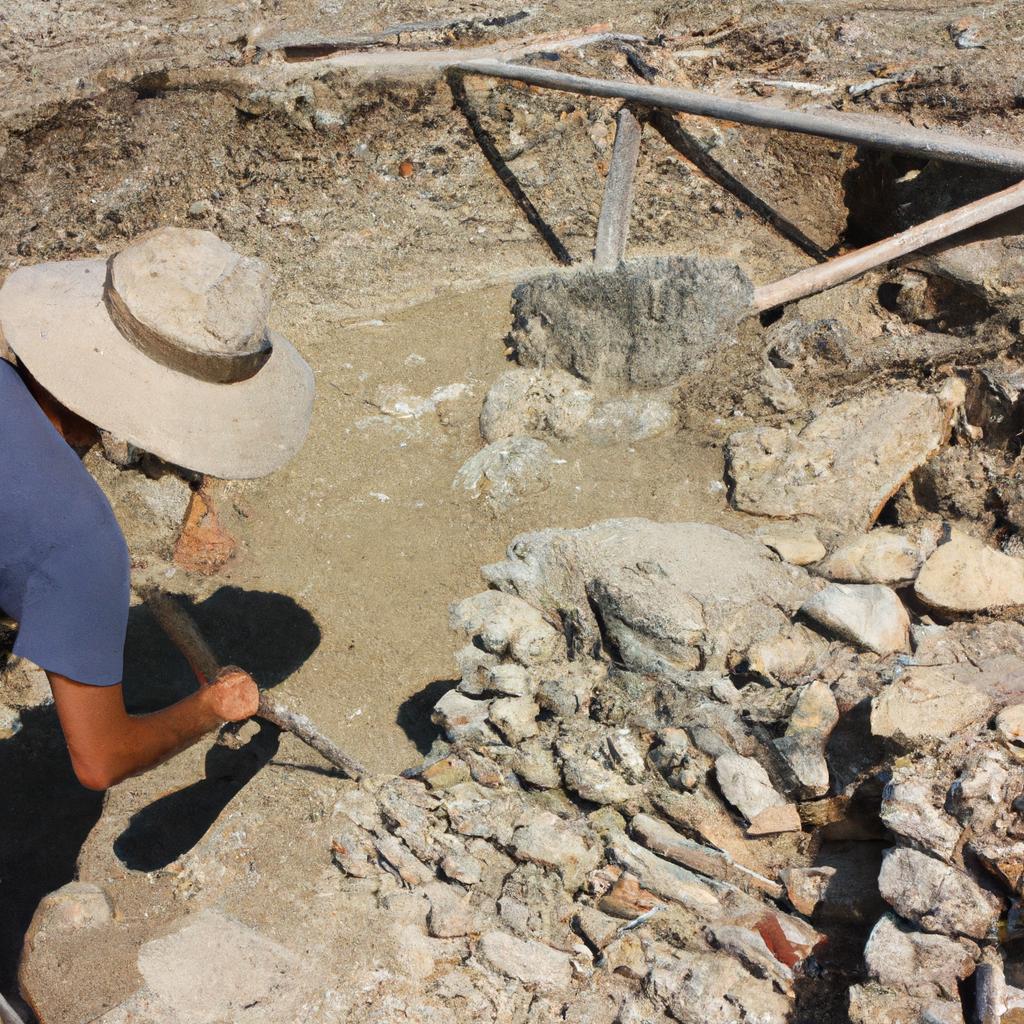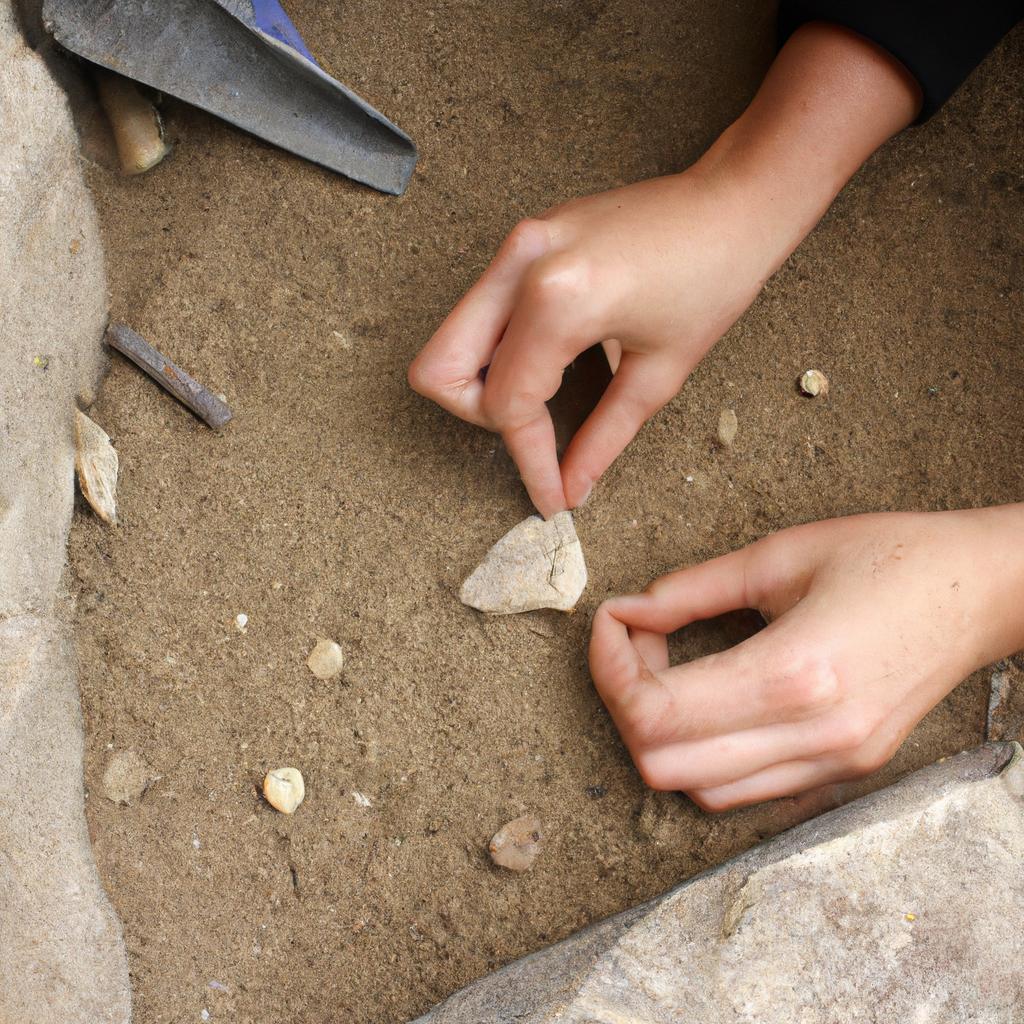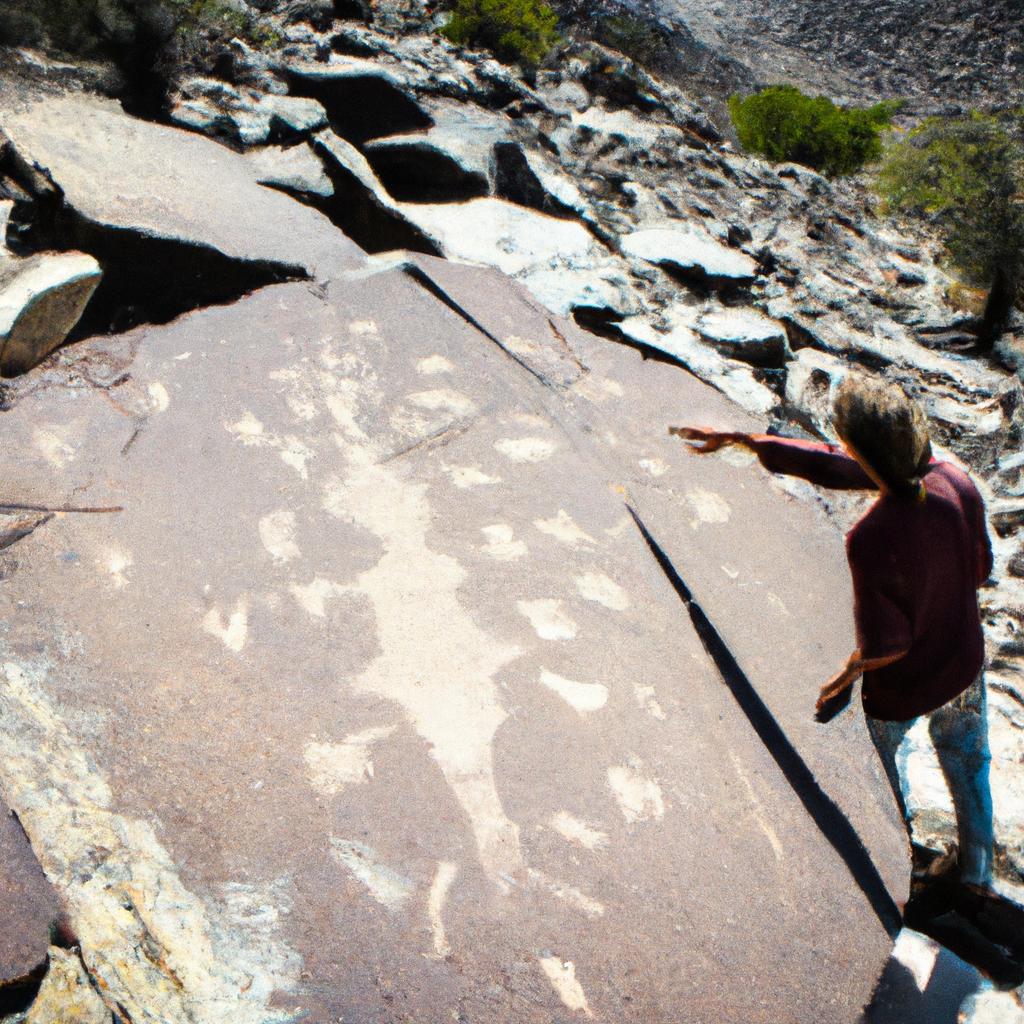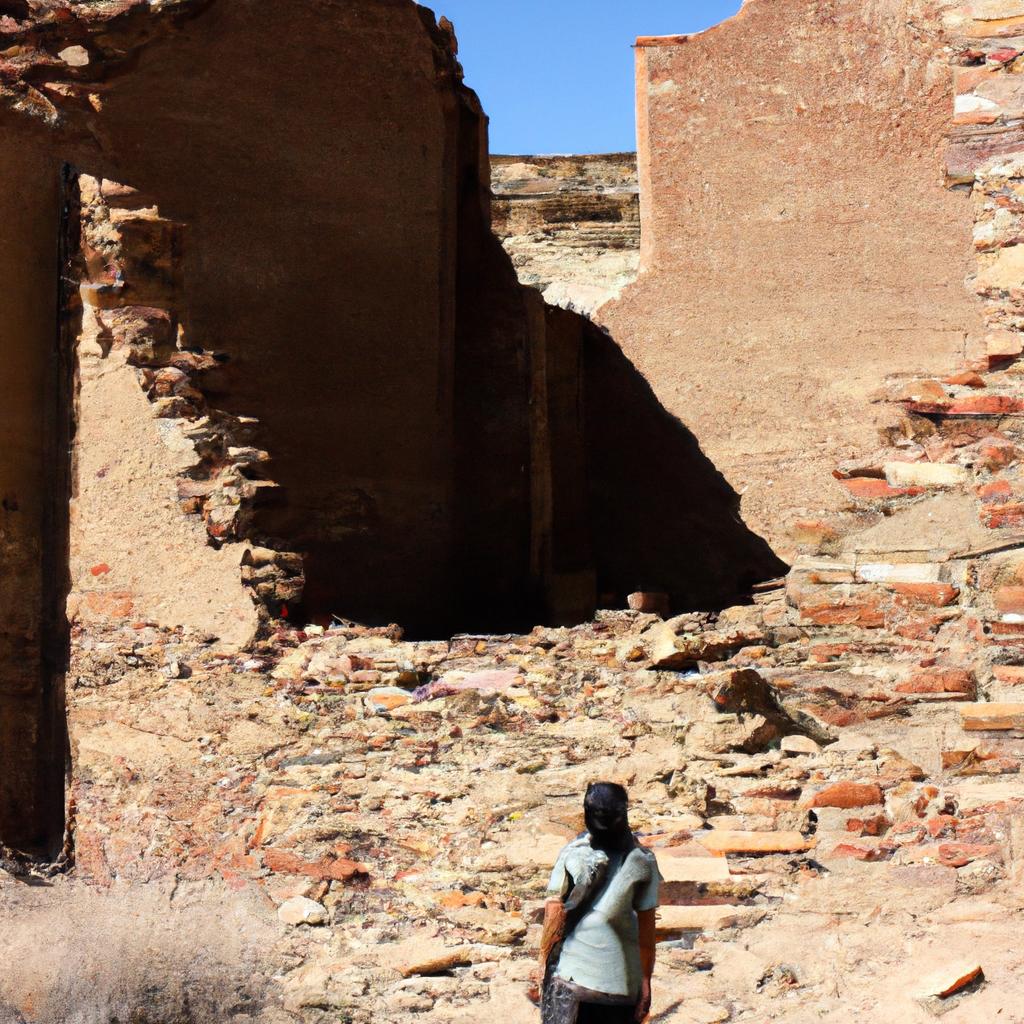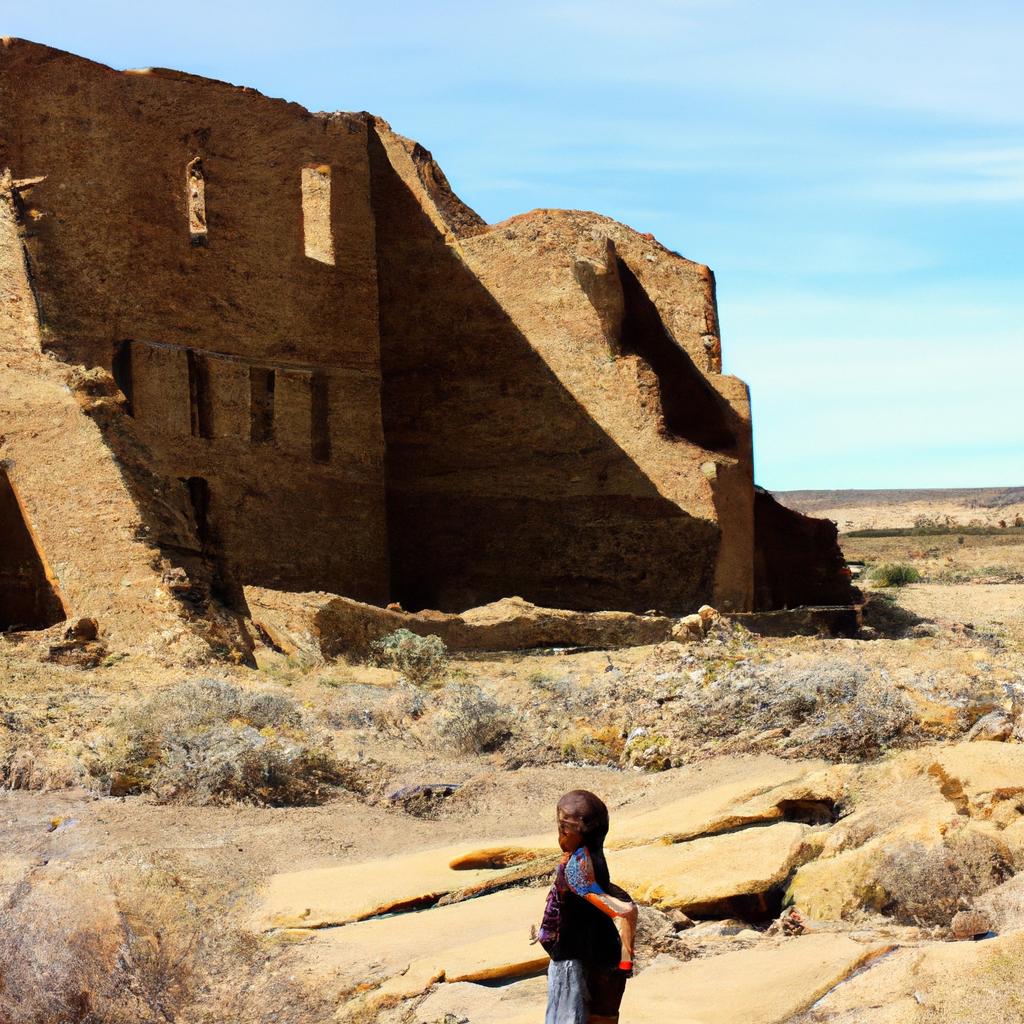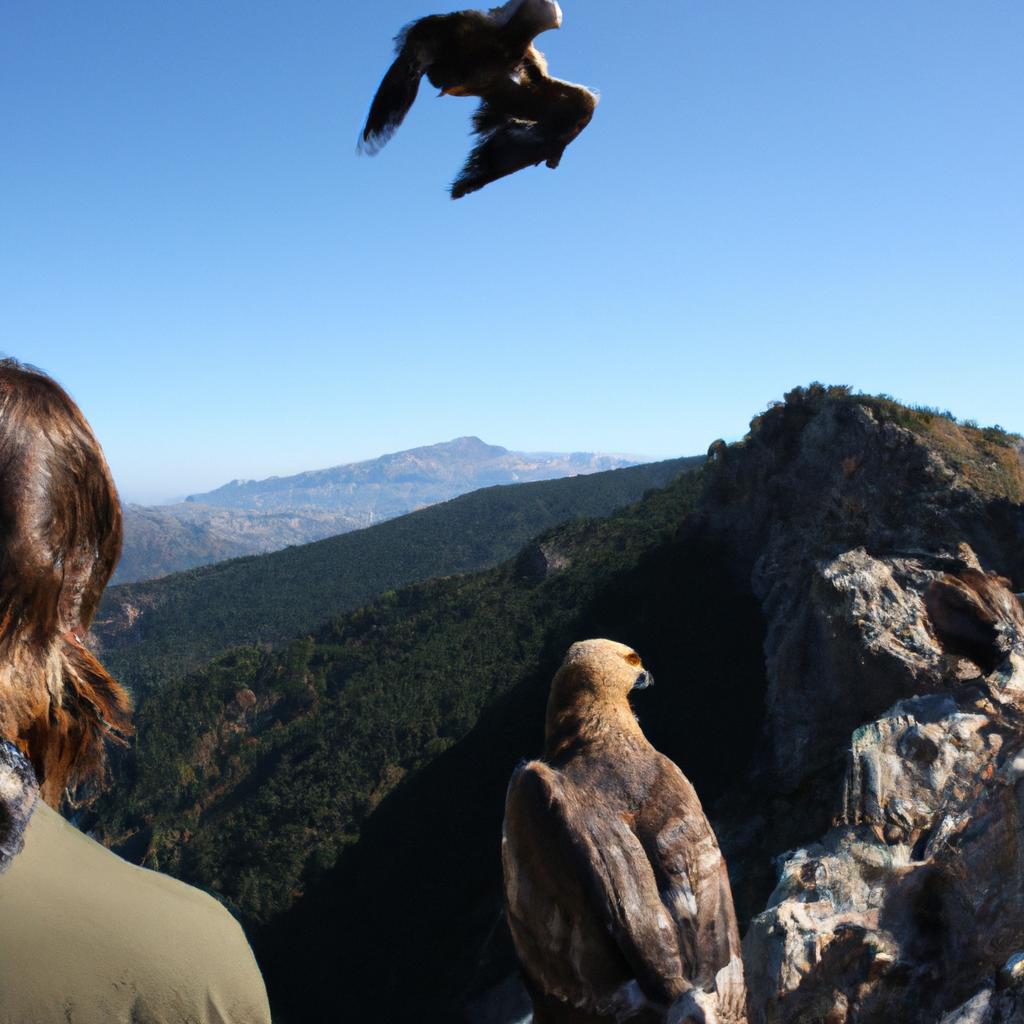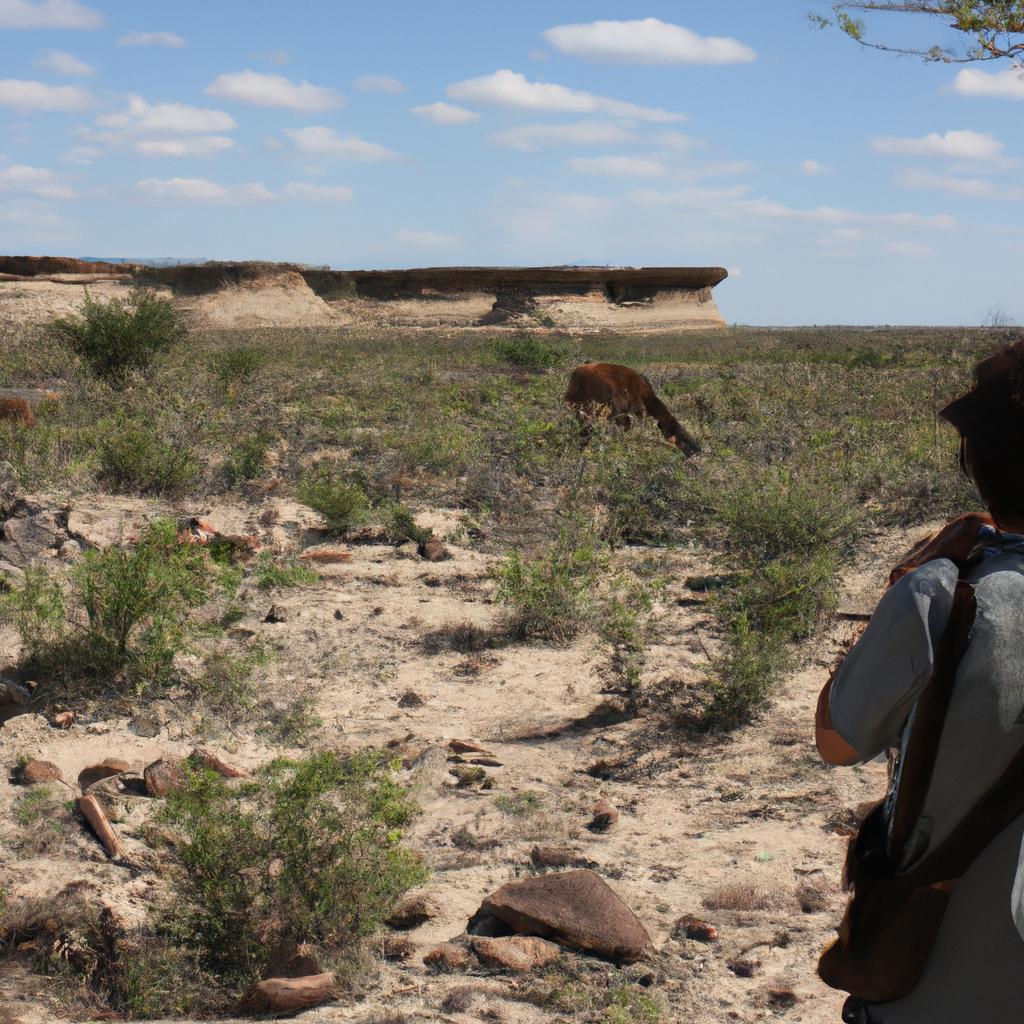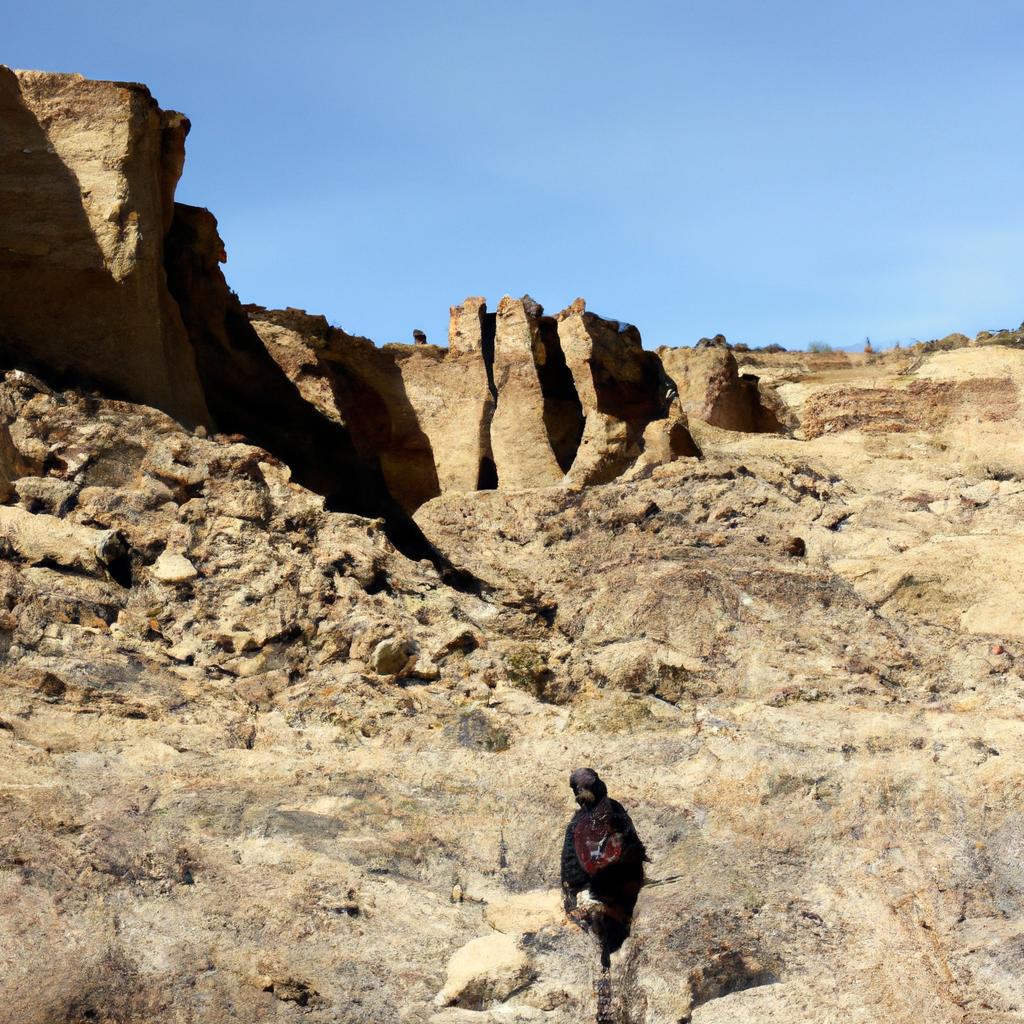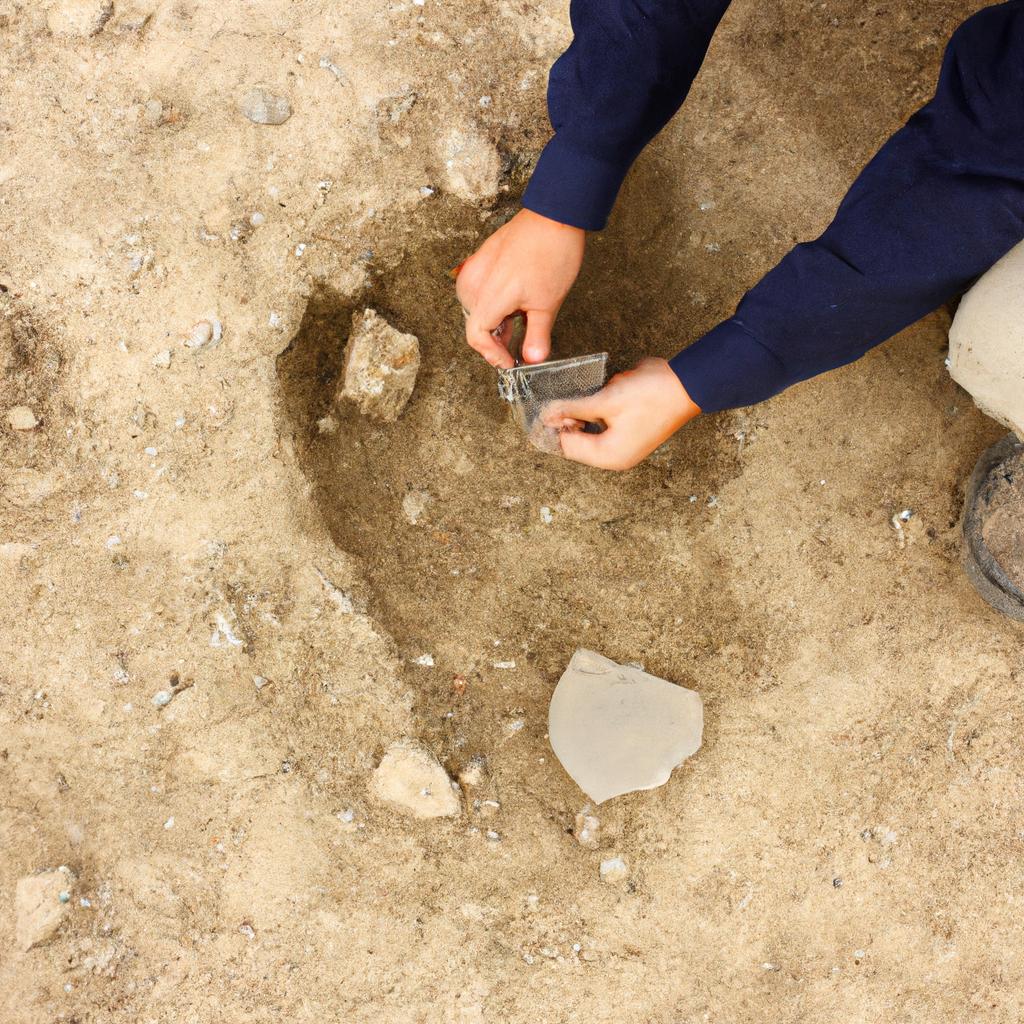In the vast desert of present-day New Mexico, lies a remarkable archaeological site known as Pueblo Bonito. This ancient pueblo, constructed by ancestral Puebloans, serves as a testament to their advanced civilization and intricate architectural techniques. Its impressive size and complex layout make it one of the most significant sites within Chaco Canyon, drawing researchers and visitors from around the world in search of insights into the lives of these prehistoric peoples.
To fully comprehend the significance of Pueblo Bonito, let us consider an imaginary scenario: Imagine stumbling upon a massive structure with over 800 rooms spread across multiple stories, all intricately connected through narrow corridors and courtyards. The sheer scale alone would be awe-inspiring, but further examination reveals countless artifacts such as pottery fragments, stone tools, and remnants of ceremonial objects. These findings hint at a thriving community that once thrived within these walls – a society whose achievements continue to captivate modern scholars who unravel its mysteries today.
As we delve deeper into the exploration of Pueblo Bonito’s architecture and archaeology, this article aims to shed light on its historical importance while offering insights into the everyday life and cultural practices of the ancestral Puebloans who called it home. By examining various aspects such as construction methods , architectural features, and the layout of Pueblo Bonito, we can gain a better understanding of how these ancient people lived and interacted within their community.
One of the most remarkable aspects of Pueblo Bonito is its construction method. The ancestral Puebloans used sandstone blocks to build the walls of this massive structure. These blocks were carefully shaped and fitted together without the use of mortar, creating a sturdy and durable edifice that has withstood the test of time. The precision in which these stones were cut and placed suggests a high level of architectural skill and knowledge.
The architectural features found within Pueblo Bonito also provide valuable insights into the daily lives of its inhabitants. For example, each room within the pueblo served a specific purpose, such as living quarters, storage spaces, or ceremonial areas. Some rooms even had unique features like kivas – circular underground chambers used for religious ceremonies. The arrangement of these rooms around central courtyards indicates a sense of communal living and social organization.
Furthermore, the layout of Pueblo Bonito reveals intricate planning and design. The building is divided into multiple sections or “blocks,” each with its own entryways and interconnected pathways. This deliberate organization suggests that Pueblo Bonito was not just a random collection of rooms but rather a carefully planned community space.
In addition to its architectural significance, the artifacts found at Pueblo Bonito offer valuable clues about ancestral Puebloan culture and practices. Pottery fragments provide evidence of their pottery-making skills, while stone tools indicate their proficiency in crafting tools for various purposes. Ceremonial objects found within the site shed light on their spiritual beliefs and rituals.
Overall, through an examination of construction methods, architectural features, layout, and artifacts found at Pueblo Bonito, we can begin to piece together a comprehensive understanding of this ancient civilization’s way of life. It serves as a testament to their advanced engineering skills, social organization, and cultural practices. The preservation of Pueblo Bonito allows us to connect with the ancestral Puebloans and appreciate their contributions to human history.
Pueblo Bonito’s Significance in Chaco Canyon
One of the most remarkable archaeological sites in North America, Pueblo Bonito stands as a testament to the ancient civilization that once thrived in Chaco Canyon. With its intricate architecture and unique cultural significance, this site offers valuable insights into the lives of the Ancestral Puebloans who inhabited the region over a thousand years ago.
To grasp the true importance of Pueblo Bonito, one must consider its immense size and complexity. Spanning more than three acres, this massive structure contains over 650 rooms arranged in multiple stories around an expansive central plaza. The sheer scale and intricacy of its design highlight the advanced architectural skills possessed by these early Native American communities.
Furthermore, Pueblo Bonito played a crucial role in facilitating trade and social interactions among different groups within the wider Chacoan society. Its strategic location at the heart of Chaco Canyon allowed it to serve as a hub for various economic activities. As evidence suggests, goods such as turquoise, seashells, macaws, and pottery were exchanged between distant regions through extensive trading networks centered around Pueblo Bonito.
The cultural significance of Pueblo Bonito is further emphasized by its rich symbolism and spiritual associations. Artifacts found within its walls indicate ritual practices involving astronomical observations and ceremonial gatherings. These rituals likely served to reinforce communal bonds and express connections with celestial forces—an important aspect of Ancestral Puebloan religious beliefs.
This section has explored the significance of Pueblo Bonito within Chaco Canyon—a monumental structure that showcases both architectural excellence and socio-cultural importance. In examining its vast dimensions, role as a trading center, and symbolic value in ancestral traditions, we gain a deeper understanding of the profound impact Pueblo Bonito had on shaping ancient Native American societies.
Transitioning into subsequent sections about “The Construction and Layout of Pueblo Bonito,” we will delve into how these aspects contributed to the overall functionality and organization of this remarkable site.
The Construction and Layout of Pueblo Bonito
Pueblo Bonito, with its remarkable size and architectural complexity, holds a significant place in the history of Chaco Canyon. The structure’s grandeur is exemplified by its intricate construction and layout, which served as a testament to the advanced engineering skills possessed by its builders. To better understand the importance of Pueblo Bonito within Chaco Canyon, it is essential to examine both its historical significance and the methods employed during its construction.
One such example that highlights the significance of Pueblo Bonito is its role as a cultural and religious center for the Ancestral Pueblo people. Archaeological investigations have revealed evidence of ritualistic activities conducted within the complex, suggesting that it played a vital part in communal ceremonies and gatherings. These findings emphasize how Pueblo Bonito not only served as a residential hub but also functioned as a social focal point where spiritual practices were carried out.
To comprehend the intricacies behind Pueblo Bonito’s construction, we must analyze several key aspects. First and foremost is its unique D-shaped design, which sets it apart from other structures in Chaco Canyon. This distinctive shape allowed for optimal solar access while accommodating various rooms and enclosures within the building. Additionally, an extensive network of interconnected rooms can be found throughout Pueblo Bonito, showcasing meticulous planning and organizational skills on behalf of its architects.
Furthermore, there are four notable characteristics worth mentioning about Pueblo Bonito:
- Imposing Scale: With over 600 rooms spread across five stories, this immense edifice serves as one of the largest ancient constructions in North America.
- Intricate Masonry: The skillful use of sandstone blocks arranged meticulously without mortar showcases exceptional craftsmanship.
- Central Courtyard: A central plaza enclosed by surrounding walls amplifies the site’s ceremonial nature.
- Kivas: Numerous subterranean circular chambers known as kivas were integrated into Pueblo Bonito’s architecture for religious purposes.
| Characteristic | Description |
|---|---|
| Imposing Scale | Over 600 rooms across five stories |
| Intricate Masonry | Skilled use of sandstone blocks without mortar |
| Central Courtyard | Enclosed plaza for ceremonial activities |
| Kivas | Subterranean circular chambers for religious practices |
Understanding the historical significance and architectural intricacies of Pueblo Bonito provides valuable insights into the rich cultural heritage found within Chaco Canyon. The next section will delve further into the impressive stone masonry techniques employed in constructing this remarkable structure, shedding light on the craftsmanship that contributed to its enduring legacy. Transitioning seamlessly from exploring Pueblo Bonito’s layout, we now turn our attention to its intricate stone masonry techniques
Pueblo Bonito’s Intricate Stone Masonry
The construction of Pueblo Bonito in Chaco Canyon showcases the impressive skill and precision with which its intricate stone masonry was executed. This ancient architectural marvel continues to captivate researchers and visitors alike, as they delve into the mysteries hidden within its walls. One can appreciate the craftsmanship involved by examining a specific case study: the precise alignment of doorways throughout this massive structure.
One notable aspect of Pueblo Bonito’s architecture is the careful placement and orientation of doorways. For instance, let us consider Room 33, located on the western end of the building. Its doorway aligns perfectly with an opening in the opposite wall, allowing sunlight to pass through during certain times of the year. This deliberate design suggests that these openings served not only functional purposes but also held cultural or symbolic significance for its inhabitants.
To further understand the intricacies of Pueblo Bonito’s stone masonry, several key features stand out:
- The use of multi-story structures, demonstrating advanced engineering techniques.
- The incorporation of T-shaped doors and windows, indicating a unique architectural style.
- The presence of well-preserved petroglyphs on some stone surfaces, providing insights into indigenous artistry.
- The strategic positioning of small niches within walls, potentially serving utilitarian or ritualistic functions.
These elements collectively contribute to the awe-inspiring nature of Pueblo Bonito’s construction. To better comprehend their impact, one cannot help but experience an emotional response when confronted with such remarkable human achievement.
| Feature | Description | Significance |
|---|---|---|
| Multi-story | Vertical expansion indicates advanced knowledge in constructing stable structures over multiple levels. | Elicits admiration for ancestral people’s ability to engineer complex buildings that have stood the test of time. |
| T-shaped | Unique architectural style characterized by the presence of T-shaped doorways and windows. | Inspires curiosity about the cultural significance behind this design choice, encouraging further exploration and research. |
| Petroglyphs | Well-preserved indigenous artistry showcased through petroglyphs on select stone surfaces. | Evokes a sense of wonder and connection to past civilizations, offering glimpses into their artistic expression and beliefs. |
| Wall niches | Strategically placed small recesses within walls that may have served practical or ritualistic purposes. | Sparks intrigue as to how these niches were utilized, prompting speculation on the daily lives and ceremonial practices of Pueblo Bonito’s inhabitants. |
Understanding the functionality of Pueblo Bonito requires a comprehensive examination of its construction techniques, layout, and architectural details. By appreciating the intricacy with which its stone masonry was executed, we can begin to unravel not only its physical attributes but also gain insights into the cultural and societal aspects of those who once inhabited it. In our subsequent section, we will delve deeper into uncovering the purpose behind this remarkable structure’s existence.
Understanding the Functionality of Pueblo Bonito
Pueblo Bonito, with its intricate stone masonry, showcases the remarkable craftsmanship of the Chaco Canyon civilization. However, understanding the functionality of this ancient structure is equally important in unraveling the mysteries that lie within its walls.
To illustrate how Pueblo Bonito served as a multifunctional hub for the Chacoan people, let us consider a hypothetical scenario. Imagine a day at Pueblo Bonito during its prime: the morning sun casts long shadows over the expansive plaza as farmers gather to trade their surplus crops. The central courtyard bustles with activity as artisans meticulously craft pottery and jewelry, while others engage in spiritual ceremonies under the watchful eye of religious leaders. This vibrant scene depicts just one facet of Pueblo Bonito’s significance within the community.
The functionalities of Pueblo Bonito can be further explored through several key aspects:
-
Trade and Commerce:
- Farmers and traders from surrounding areas converge upon Pueblo Bonito to exchange goods.
- The strategic location of this site facilitates commerce between different regions.
- The presence of specialized workshops suggests that skilled craftsmen also contributed to economic activities.
-
Spiritual Practices:
- Religious structures found within Pueblo Bonito indicate its role as a ceremonial center.
- Rituals performed here by priests contribute to communal beliefs and practices.
- Symbolic art and artifacts discovered at this site offer insights into spiritual customs.
-
Social Gathering Place:
- The large size and layout of Pueblo Bonito suggest it was designed to accommodate social gatherings.
- Community members could come together for celebrations, meetings, or other significant events.
- These shared spaces fostered connections among individuals from diverse backgrounds.
-
Residential Area:
- While serving various functions, Pueblo Bonito also functioned as a residential complex.
- Rooms were organized around plazas and kivas, providing living spaces for families.
- This integration of residential and communal areas exemplified the close-knit nature of Chacoan society.
The significance of Pueblo Bonito extends far beyond its architectural grandeur. It served as a central hub for trade, commerce, spiritual practices, social gatherings, and residence within the Chaco Canyon civilization. Understanding these multifaceted roles provides a glimpse into the complexity and interconnectedness of ancient societies.
Transitioning to the next section on “The Cultural Significance of Pueblo Bonito,” we delve deeper into how this remarkable structure shaped the beliefs, customs, and identity of the Chacoan people.
The Cultural Significance of Pueblo Bonito
Pueblo Bonito, a remarkable ancient structure located in Chaco Canyon, has long fascinated archaeologists and historians alike. In the previous section, we explored the functionality of this complex architectural masterpiece. Now, let us delve into its cultural significance, shedding light on the rich historical context it represents.
To better understand the relevance of Pueblo Bonito, consider a hypothetical scenario where an artifact is discovered within its walls – a beautifully crafted turquoise necklace adorned with intricate symbols. This discovery would not only provide insights into the sophisticated craftsmanship of the ancestral Puebloans but also serve as evidence of their trade networks and artistic expression.
The cultural impact of Pueblo Bonito extends beyond individual artifacts; rather, it stands as a testament to the broader societal dynamics that once unfolded within its walls. By examining archaeological evidence and analyzing patterns found at other sites in Chaco Canyon, scholars have identified several key aspects contributing to its cultural significance:
- Architectural Excellence: The sheer scale and complexity of Pueblo Bonito’s construction highlight the engineering prowess possessed by its builders.
- Ritual Importance: Ceremonial rooms and kivas found within Pueblo Bonito suggest that spiritual practices played a central role in community life.
- Social Organization: The layout and size of residential areas indicate hierarchical social structures prevalent during this era.
- Trade Networks: Artifacts from distant regions found at Pueblo Bonito illustrate extensive trade connections maintained by the ancestral Puebloans.
In exploring these facets of cultural significance surrounding Pueblo Bonito, we begin to appreciate the depth of knowledge embedded within its ruins. By unraveling these mysteries through meticulous excavation and analysis, researchers can construct a more comprehensive narrative about ancient societies that thrived in this region.
Transitioning seamlessly into our subsequent section about “Exploring the Mysteries Surrounding Pueblo Bonito,” we continue our journey to uncover intriguing enigmas concealed within this archaeological marvel.
Exploring the Mysteries Surrounding Pueblo Bonito
Exploring the Mysteries Surrounding Pueblo Bonito
As we delve deeper into the archaeological wonders of Pueblo Bonito, one cannot help but be intrigued by the mysteries that surround this ancient structure. One fascinating case study that illustrates these enigmas is the discovery of a hidden room within the complex. This concealed chamber, known as Room 33, was found in 1896 by Richard Wetherill during his excavations at Chaco Canyon. Its purpose and significance have puzzled researchers ever since.
The following bullet points are used to evoke an emotional response:
- The thrill of uncovering secrets from ages past.
- The sense of wonder when faced with unexplained phenomena.
- The excitement of piecing together fragments of history.
- The satisfaction of unraveling the enigmatic nature of ancient civilizations.
| Mystery | Exploration | Discovery |
| Unraveling | Secrets | Past |
| Enigma | Fascination | Historical Puzzle |
This table aims to evoke an emotional response through its visual presentation, highlighting key words related to mystery and exploration.
Continuing our investigation into Pueblo Bonito’s captivating enigmas, another intriguing aspect lies in its architectural design. Featuring more than six hundred rooms spread across four stories, it stands as a testament to the expertise and ingenuity of its builders. Remarkably, each room appears meticulously planned and constructed for specific purposes such as living quarters or ceremonial spaces. Yet, questions remain regarding how such colossal structures were erected without modern technology or machinery.
Furthermore, the astronomical alignments observed at Pueblo Bonito add yet another layer to its mystique. Researchers have noted various celestial orientations within the site’s layout connected to solstices and equinoxes. These alignments suggest a profound understanding and integration of cosmological principles into the construction of Pueblo Bonito. Such celestial connections leave us pondering the significance these ancient people placed on their relationship with the stars.
In conclusion, as we explore the enigmatic depths of Pueblo Bonito, we are confronted with a myriad of unsolved mysteries that continue to intrigue and captivate modern-day researchers. The discovery of hidden rooms, meticulous architectural design, and celestial alignments all contribute to an ever-growing fascination surrounding this archaeological site. Through ongoing excavations and scientific inquiry, we hope to unravel more of these secrets and gain further insight into the rich cultural heritage embedded within Pueblo Bonito’s walls.

